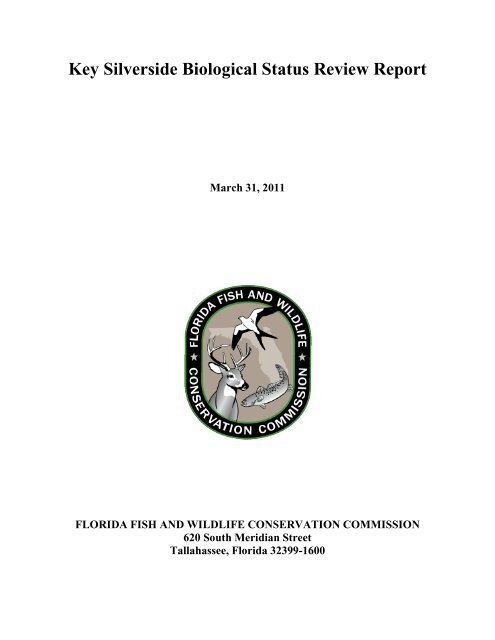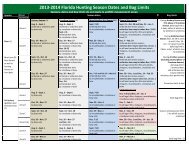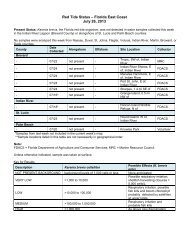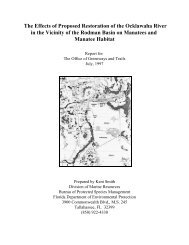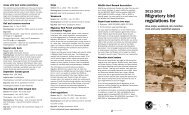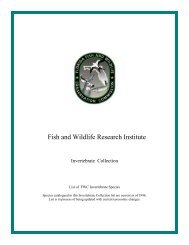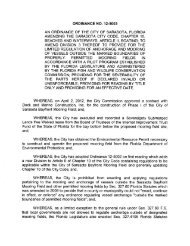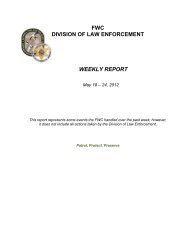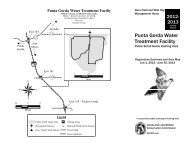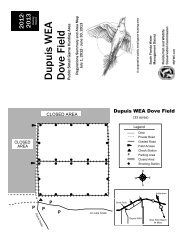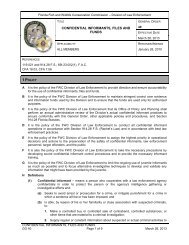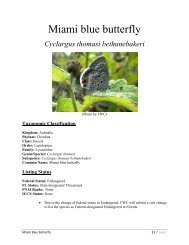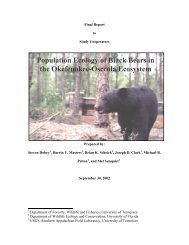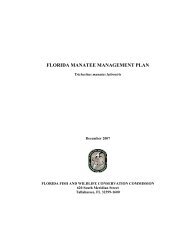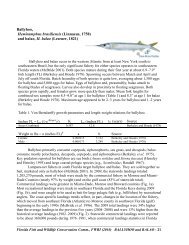Key Silverside Biological Status Review Report - Florida Fish and ...
Key Silverside Biological Status Review Report - Florida Fish and ...
Key Silverside Biological Status Review Report - Florida Fish and ...
You also want an ePaper? Increase the reach of your titles
YUMPU automatically turns print PDFs into web optimized ePapers that Google loves.
<strong>Key</strong> <strong>Silverside</strong> <strong>Biological</strong> <strong>Status</strong> <strong>Review</strong> <strong>Report</strong><br />
March 31, 2011<br />
FLORIDA FISH AND WILDLIFE CONSERVATION COMMISSION<br />
620 South Meridian Street<br />
Tallahassee, <strong>Florida</strong> 32399-1600
EXECUTIVE SUMMARY<br />
<strong>Biological</strong> <strong>Status</strong> <strong>Review</strong> for the<br />
<strong>Key</strong> <strong>Silverside</strong><br />
(Menidia conchorum)<br />
March 31, 2011<br />
The <strong>Florida</strong> <strong>Fish</strong> <strong>and</strong> Wildlife Conservation Commission (FWC) directed staff to<br />
evaluate all species listed as Threatened or Species of Special Concern as of November 8, 2010<br />
that had not undergone a status review in the past decade. Public information on the status of the<br />
<strong>Key</strong> silverside, Menidia conchorum, was sought from September 17 to November 1, 2010. The<br />
members of a <strong>Biological</strong> <strong>Review</strong> Group (BRG) met on November 18-19. Group members were<br />
Martha Bademan (FWC lead), George Burgess (<strong>Florida</strong> Museum of Natural History), <strong>and</strong> Grant<br />
Gilmore (Estuarine, Coastal, <strong>and</strong> Ocean Science, Inc.) (Appendix 1). In accordance with rule<br />
68A-27.0012, <strong>Florida</strong> Administrative Code (F.A.C.), the BRG was charged with evaluating the<br />
biological status of the <strong>Key</strong> silverside using criteria included in definitions in 68A-27.001,<br />
F.A.C., <strong>and</strong> following the protocols in the Guidelines for Application of the IUCN Red List<br />
Criteria at Regional Levels (Version 3.0) <strong>and</strong> Guidelines for Using the IUCN Red List<br />
Categories <strong>and</strong> Criteria (Version 8.1). Please visit<br />
http://myfwc.com/wildlifehabitats/imperiled/listing-action-petitions/ to view the listing process<br />
rule <strong>and</strong> the criteria found in the definitions.<br />
In late 2010, staff developed the initial draft of this report which included BRG findings<br />
<strong>and</strong> a preliminary listing recommendation from staff. The draft was sent out for peer review <strong>and</strong><br />
the reviewers’ input has been incorporated to create this final report. The draft report, peer<br />
reviews, <strong>and</strong> information received from the public are available as supplemental materials at<br />
http://myfwc.com/wildlifehabitats/imperiled/biological-status/.<br />
The BRG concluded from the biological assessment that the <strong>Key</strong> silverside met listing<br />
criteria. Based on the literature review, information received from the public, <strong>and</strong> the BRG<br />
findings, staff recommends listing the <strong>Key</strong> silverside as a Threatened species.<br />
This work was supported by a Conserve Wildlife Tag grant from the Wildlife Foundation<br />
of <strong>Florida</strong>. FWC staff gratefully acknowledges the assistance of the biological review group<br />
members <strong>and</strong> peer reviewers. Staff would also like to thank Dr. Joseph Mitchell who served as a<br />
data compiler on the species report.<br />
BIOLOGICAL INFORMATION<br />
Life History References – Bloom et al. 2009, Conover et al. 2000, Duggins et al. 1986,<br />
Getter 1981, Gilbert 1978.<br />
Taxonomic Classification – The taxonomic status of the <strong>Key</strong> silverside (Menidia<br />
conchorum) is unclear. The <strong>Key</strong> silverside may be distinguished from other Menidia silversides<br />
by morphometric characteristics; however, these measures are not always reliable because of<br />
intra- <strong>and</strong> inter-specific morphological variations (Duggins et al. 1986, Conover et al. 2000).<br />
<strong>Key</strong> <strong>Silverside</strong> <strong>Biological</strong> <strong>Status</strong> <strong>Review</strong> <strong>Report</strong> 2
Allozyme <strong>and</strong> mitochondrial DNA analyses suggest that the <strong>Key</strong> silverside is not a distinct<br />
species, but an ecotype or subspecies of M. peninsulae, the tidewater silverside (Duggins et al.<br />
1986, Bloom et al. 2009). For the purposes of this biological status review, <strong>Key</strong> silverside is<br />
considered a distinct taxonomic unit.<br />
Population <strong>Status</strong> <strong>and</strong> Trend – The total number of <strong>Key</strong> silversides in <strong>Florida</strong> is<br />
unknown. Conover et al. (2000) found little evidence of a <strong>Key</strong> silverside population decline<br />
during a 1999 survey in which 2,680 specimens were collected. The <strong>Key</strong> silverside seems to be<br />
abundant in the limited area where it occurs; however, local population numbers fluctuate<br />
(Gilbert 1978, Getter 1981, Conover et al. 2000). <strong>Key</strong> silversides are believed to live up to one<br />
year (Getter 1981).<br />
Geographic Range <strong>and</strong> Distribution – The <strong>Key</strong> silverside is endemic to the lower <strong>and</strong><br />
middle <strong>Florida</strong> <strong>Key</strong>s. <strong>Key</strong> silversides have been documented in lagoons on Long <strong>Key</strong>, Grassy<br />
<strong>Key</strong>, Big Pine <strong>Key</strong>, No Name <strong>Key</strong>, Little Torch <strong>Key</strong>, Cudjoe <strong>Key</strong>, Sugarloaf <strong>Key</strong>, Saddle Bunch<br />
<strong>Key</strong>, Rockl<strong>and</strong> <strong>Key</strong>, Boca Chica, <strong>and</strong> <strong>Key</strong> West. However, the presence of <strong>Key</strong> silverside in<br />
available habitats is sporadic <strong>and</strong> ephemeral (Getter 1981, Conover et al. 2000). Conover et al.<br />
(2000) collected silversides on <strong>Key</strong> Largo <strong>and</strong> mainl<strong>and</strong> <strong>Florida</strong> north of <strong>Key</strong> Largo that were<br />
identified as either <strong>Key</strong> silverside or tidewater silverside. Duggins et al. (1986) <strong>and</strong> Conover et<br />
al. (2000) hypothesized that the <strong>Key</strong> silverside also occurs at other sites in the <strong>Key</strong>s that are not<br />
accessible by road or easily sampled.<br />
The <strong>Key</strong> silverside is generally found in protected, saline lagoons <strong>and</strong> ponds with<br />
restricted tidal exchange (Getter 1981, Conover et al. 2000). However, the <strong>Key</strong> silverside is<br />
known to be tolerant of a wide range of salinities (Getter 1981).<br />
Quantitative Analyses – We are not aware of a population viability analysis for the <strong>Key</strong><br />
silverside.<br />
BIOLOGICAL STATUS ASSESSMENT<br />
Threats – Habitat loss <strong>and</strong> alteration is a major threat to the <strong>Key</strong> silverside. Several<br />
documented <strong>Key</strong> silverside habitat sites have been filled, destroyed, or altered by development<br />
(Gilbert 1978, Getter 1981, Duggins et al. 1986, Conover et al. 2000). Since Conover et al.’s<br />
(2000) survey of <strong>Key</strong> silverside habitats, habitat sites have been destroyed, reduced, or altered by<br />
development, hurricanes, <strong>and</strong> flooding (Getter, personal communication 2/3/11). Because the<br />
lagoons <strong>and</strong> ponds occupied by <strong>Key</strong> silversides are limited, development or alteration of<br />
remaining habitat could be detrimental to <strong>Key</strong> silverside subpopulations. Conover et al. (2000)<br />
predicted that as the protected lagoons inhabited by <strong>Key</strong> silversides are inundated <strong>and</strong> joined to<br />
open water, the <strong>Key</strong> silverside would be replaced by the hardhead silverside, Atherinomorus<br />
stipes. Getter noted that piscivorous fish such as snapper <strong>and</strong> grouper were more abundant at<br />
some <strong>Key</strong> silverside sites in 2010 than during surveys taken in the 1970s (personal<br />
communication 2/3/11). Getter (1981) also noted that a population of <strong>Key</strong> silversides<br />
disappeared from a pond on Big Pine <strong>Key</strong> following introduction of the blue gill, Lepomis<br />
macrochirus, <strong>and</strong> the appearance of external trematode parasites on the <strong>Key</strong> silversides.<br />
<strong>Key</strong> <strong>Silverside</strong> <strong>Biological</strong> <strong>Status</strong> <strong>Review</strong> <strong>Report</strong> 3
Population Assessment – Findings from the BRG are included in the <strong>Biological</strong> <strong>Status</strong><br />
<strong>Review</strong> Information Findings table, below.<br />
LISTING RECOMMENDATION<br />
Based on the finding of the <strong>Key</strong> silverside BRG <strong>and</strong> subsequent consultation with other<br />
FWC fish experts, staff recommends that the <strong>Key</strong> silverside (Menidia conchorum) be listed as a<br />
Threatened species because it met criteria for listing in accordance with rule 68A-27.0012,<br />
F.A.C.<br />
SUMMARY OF THE INDEPENDENT REVIEW<br />
Comments were received from three reviewers, Dr. Charles D. Getter, Dr. William F.<br />
Loftus (Aquatic Research & Communication, LLC), <strong>and</strong> Ms. Calusa Horn (NOAA <strong>Fish</strong>eries<br />
Service). Appropriate editorial changes recommended by the reviewers were made to the report.<br />
While all reviewers agreed with the staff recommendation, one reviewer suggested that<br />
information regarding the threat of sea level rise on <strong>Key</strong> silverside should be factored into the<br />
biological status review. According to IUCN guidance documents, projected population decline<br />
(criterion A3) should be estimated over the the next ten years or three generations, whichever is<br />
longer, up to a maximum of 100 years. Although sea level rise could reduce <strong>Key</strong> silverside<br />
habitat <strong>and</strong> populations over the next several decades, the BRG did not include sea level rise as a<br />
threat in the biological status report because sea level rise is not expected to reduce the<br />
population size of <strong>Key</strong> silverside by 30% or greater in the next ten years (generation length is<br />
presumed to be less than one year). One reviewer noted the discrepancy between the IUCN’s<br />
classification of the species (lower risk/near threatened) <strong>and</strong> our proposed classification of<br />
“threatened,” <strong>and</strong> suggested that new information may have become available since their review<br />
(1996). The IUCN account (http://www.iucnredlist.org/apps/redlist/details/13145/0) does not<br />
provide documentation for their classification, but it does note that it needs updating. Peer<br />
reviews are available at MyFWC.com<br />
<strong>Key</strong> <strong>Silverside</strong> <strong>Biological</strong> <strong>Status</strong> <strong>Review</strong> <strong>Report</strong> 4
LITERATURE CITED<br />
Bloom D.D., K.R. Piller, J. Lyons, N. Mercado-Silva, M. Medina-Nava. 2009. Systematics <strong>and</strong><br />
biogeography of the silverside tribe Menidiini (Teleostomi: Antherinopsidae) based on<br />
the mitochondrial ND2 gene. Copeia 2009:408-417.<br />
Conover, D.O., S. Munch, T.E. Lankford Jr. 2000. Current status of the <strong>Key</strong> silverside, Menidia<br />
conchorum, in southern <strong>Florida</strong>. U.S. Geological Survey.<br />
http://sero.nmfs.noaa.gov/pr/SOC/Revised%20SOC%20webpage%202010/<strong>Key</strong>%20Silve<br />
rside/Menidia%20conchorum%20FINAL-1.pdf Cited 19 Oct 2010.<br />
Duggins, C.F., A.A. Karlin, K. Relyea, R.W. Yerger. 1986. Systematics of the <strong>Key</strong> silverside,<br />
Menidia conchorum, with comments on other Menidia species (Pisces: Antheridnidae).<br />
Tulane Studies in Zoology <strong>and</strong> Botany 25:133-150.<br />
Getter, C.D. 1981. Ecology <strong>and</strong> survival of the key silverside, Menidia conchorum, an atherinid<br />
fish endemic to the <strong>Florida</strong> <strong>Key</strong>s. PhD dissertation, University of Miami, Miami, FL.<br />
Gilbert, C.R. 1978. Menidia conchorum. In: Rare <strong>and</strong> Endangered Biota of <strong>Florida</strong>. P.C.H.<br />
Prichard, Series Editor. 4: <strong>Fish</strong>es. University Presses of <strong>Florida</strong>.<br />
<strong>Key</strong> <strong>Silverside</strong> <strong>Biological</strong> <strong>Status</strong> <strong>Review</strong> <strong>Report</strong> 5
<strong>Biological</strong> <strong>Status</strong> <strong>Review</strong> Information<br />
Findings<br />
<strong>Key</strong> <strong>Silverside</strong> <strong>Biological</strong> <strong>Status</strong> <strong>Review</strong> <strong>Report</strong> 6<br />
Species/taxon: <strong>Key</strong> silverside<br />
Date: 11/18/10<br />
Assessors: Martha Bademan, Grant Gilmore,<br />
George Burgess<br />
Generation length:
. Continuing decline, observed, inferred or projected in any of the following: (i)<br />
extent of occurrence; (ii) area of occupancy; (iii) area, extent, <strong>and</strong>/or quality of<br />
habitat; (iv) number of locations or subpopulations; (v) number of mature individuals<br />
c. Extreme fluctuations in any of the following: (i) extent of occurrence; (ii) area of<br />
occupancy; (iii) number of locations or subpopulations; (iv) number of mature<br />
individuals<br />
(C) Population Size <strong>and</strong> Trend<br />
Population size estimate to number fewer than 10,000 mature individuals AND<br />
EITHER<br />
loss of habitat, introduced species,<br />
decline in water quality<br />
No - fluctuations, but not "extreme"<br />
by IUCN st<strong>and</strong>ards<br />
Abundant where it is found; >2600<br />
sampled over six day period by<br />
Conover (2000)<br />
<strong>Key</strong> <strong>Silverside</strong> <strong>Biological</strong> <strong>Status</strong> <strong>Review</strong> <strong>Report</strong> 7<br />
estimated Y for iii Getter 1981,<br />
Conover et al.<br />
2000<br />
estimated N Getter 1981<br />
estimated N<br />
N/A<br />
Getter 1981,<br />
Duggins 1986,<br />
Conover et al.<br />
2000<br />
(c)1. An estimated continuing decline of at least 10% in 10 years or 3 generations,<br />
whichever is longer (up to a maximum of 100 years in the future) OR<br />
(c)2. A continuing decline, observed, projected, or inferred in numbers of mature<br />
individuals AND at least one of the following:<br />
N/A<br />
a. Population structure in the form of EITHER<br />
(i) No subpopulation estimated to contain more than 1000 mature individuals;<br />
OR<br />
N/A<br />
(ii) All mature individuals are in one subpopulation N/A<br />
b. Extreme fluctuations in number of mature individuals<br />
(D) Population Very Small or Restricted, EITHER<br />
N/A<br />
(d)1. Population estimated to number fewer than 1,000 mature individuals; OR Abundant where it is found; estimated N Getter 1981,<br />
Conover (2000) captured >2600<br />
Conover et al.<br />
over 6 days<br />
2000<br />
(d)2. Population with a very restricted area of occupancy (typically less than 20 km 2<br />
[8 mi 2 AOO is greater than 8 sq mi; more estimated N Getter 1981,<br />
]) or number of locations (typically 5 or fewer) such that it is prone to the than 10 locations<br />
Duggins 1986,<br />
effects of human activities or stochastic events within a short time period in an<br />
Conover et al.<br />
uncertain future<br />
(E) Quantitative Analyses<br />
2000<br />
e1. Showing the probability of extinction in the wild is at least 10% within 100 years no quantitative analysis N/A<br />
Initial Finding (Meets at least one of the criteria/sub-criteria OR Does not meet any of the criteria/subcriteria)<br />
Reason (which criteria/sub-criteria are<br />
met)<br />
meets criteria for listing B: b(1), b(2) + a, b(iii)<br />
Is species/taxon endemic to <strong>Florida</strong>? (Y/N) Yes<br />
If Yes, your initial finding is your final finding. Copy the initial finding <strong>and</strong> reason to the final finding space below. If No, complete the<br />
regional assessment sheet <strong>and</strong> copy the final finding from that sheet to the space below.<br />
Final Finding (Meets at least one of the criteria/sub-criteria OR Does not meet any of the criteria/subcriteria)<br />
Reason (which criteria/sub-criteria are<br />
met)<br />
meets criteria for listing B: b(1), b(2) + a, b(iii)
Additional Notes: The available genetic studies are inadequate for determining the taxonomic<br />
status of the <strong>Key</strong> silverside. Detailed study of the <strong>Florida</strong> populations of Menidia peninsulae <strong>and</strong><br />
M. conchorum are needed to determine if they are separate species <strong>and</strong> to underst<strong>and</strong> the<br />
continuity of variation throughout their range. If the <strong>Key</strong> silverside is actually a subspecies or<br />
population of M. peninsulae, is the <strong>Key</strong> silverside variation extreme or are there other distinct<br />
populations of M. peninsulae throughout their range? Clinal variation is common for Menidia<br />
silversides. Distribution <strong>and</strong> evolutionary processes are similarly shown in other related forms<br />
(Fundulus, Killifishes, sheepshead minnow); there may be populations of other species that will<br />
be worthy of listing review in the future.<br />
<strong>Key</strong> <strong>Silverside</strong> <strong>Biological</strong> <strong>Status</strong> <strong>Review</strong> <strong>Report</strong> 8
APPENDIX 1. Brief biographies of the <strong>Key</strong> silverside <strong>Biological</strong> <strong>Review</strong> Group members.<br />
Martha Bademan has a B.S. in biology from Wake Forest University <strong>and</strong> a M.S. in marine<br />
biology from <strong>Florida</strong> Institute of Technology. She has worked in the FWC’s Division of Marine<br />
<strong>Fish</strong>eries Management, Analysis <strong>and</strong> Rulemaking Subsection since 2008. As an Environmental<br />
Specialist, she has analyzed fishery information for the management of several of <strong>Florida</strong>’s<br />
recreational, commercial, <strong>and</strong> ornamental fish <strong>and</strong> invertebrate species.<br />
George Burgess is Director of the <strong>Florida</strong> Program for Shark Research at the <strong>Florida</strong> Museum of<br />
Natural History, Gainesville. He is a specialist in fisheries conservation, ecology, <strong>and</strong><br />
biogeography, with a particular focus on icthyofauna of South <strong>Florida</strong>. Mr. Burgess earned his<br />
MS at the University of <strong>Florida</strong>, <strong>and</strong> has numerous peer-reviewed publications to his credit.<br />
George also manages the National Sawfish Encounter database.<br />
R. Grant Gilmore received his Ph.D., from the <strong>Florida</strong> Institute of Technology in 1988. Dr.<br />
Gilmore is a Senior Scientist with Estuarine, Coastal <strong>and</strong> Ocean Science, Inc., (ECOS). Dr.<br />
Gilmore founded ECOS in 2004 after spending 32 years with the Harbor Branch Oceanographic<br />
Institution, Fort Pierce, <strong>Florida</strong> <strong>and</strong> Dynamac Corp. at the Kennedy Space Center. Dr. Gilmore<br />
has been studying the fish community <strong>and</strong> ecology of <strong>Florida</strong> <strong>and</strong> Caribbean Sea for the past 35<br />
years <strong>and</strong> has published over 70 technical <strong>and</strong> popular papers on fish ecology <strong>and</strong> life history<br />
including reproductive habits of spotted seatrout, snook, groupers, <strong>and</strong> sharks.<br />
<strong>Key</strong> <strong>Silverside</strong> <strong>Biological</strong> <strong>Status</strong> <strong>Review</strong> <strong>Report</strong> 9
APPENDIX 2. Summary of letters <strong>and</strong> emails received during the solicitation of<br />
information from the public period of September 17, 2010 through November 1, 2010.<br />
No information about this species was received during the public information request<br />
period.<br />
<strong>Key</strong> <strong>Silverside</strong> <strong>Biological</strong> <strong>Status</strong> <strong>Review</strong> <strong>Report</strong> 10


